Made By:
Mega House
Scale:
1/24
MSRP:
¥26,000
| Overview: | |
|---|---|
| Packaging (Design): | 10/10 |
| Packaging (Durability): | 10/10 |
| Casting (Body): | 10/10 |
| Casting (Interior): | 10/10 |
| Casting (Chassis): | 10/10 |
| Casting (Engine): | N/A |
| Paint (Exterior): | 10/10 |
| Paint (Interior): | 10/10 |
| Paint (Trim/Graphics): | 10/10 |
| Overall Panel Fit: | 10/10 |
| Total Score: | 10/10 |

Other Comic & Manga Models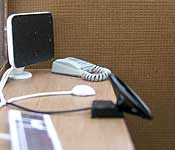
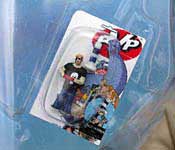
Cyber Formula Asurada AKF-11 (Review)
Ctrl-Alt-Del Zeke
Cyber Formula Experion Z/A-8 (Review)
The Circuit Wolf Lotus Europa
Cyber Formula Fire Superion (Review)
Transformers Optimus Prime
Cyber Formula Super Asurada (Review)
Detective Comics #377 Batmobile
The Silver Spectrum Ford Deluxe
Detective Comics #400 Batmobile
Jigoro Jigorou Toyota Celica
Misfile XR4Ti
PvP Dexter Jettster
Over Rev! Toyota MR2
Detective Comics #597 Batmobile
The Circuit Wolf Jota
DC Bombshells Harley Quinn (Review)
Dilbert Carbicle
Pearls Before Swine Revenge-O-Mobile
Other Cartoon & Anime Models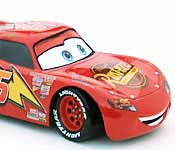
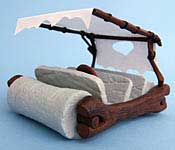
Jimmy Neutron Rocket
Hello Kitty Skyline GT-R (Review)
Cyber Formula Super Asurada (Review)
Rugrats Movie Reptar Wagon (Review)
101 Dalmatians Cruella's Car (Review)
Evangelion Renault Alpine A310
Big Hero 6 Baymax (Review)
WALL·E
F&F: Spy Racers Thresher (Review)
F&F: Spy Racers Crawler (Review)
eX-Driver Lotus Europa
Vifam Twinklehead
Roadster Racers Daisy (Review)
1992 Batman:TAS Batmobile
Paprika Aston Martin DB7
Gunsmith Cats Shelby GT500
Max Steel Turbo Racer (Review)
TMNT Party Wagon (Review)
M.A.S.K. Thunderhawk
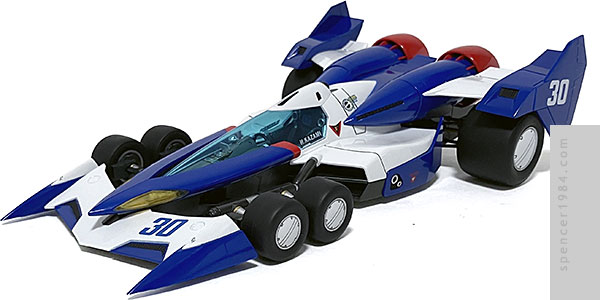
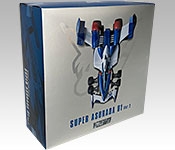
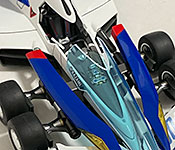
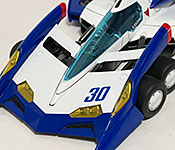
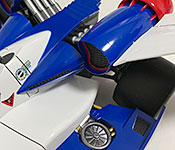
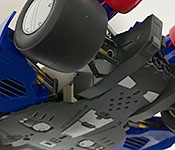
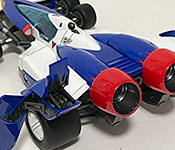
Background
In the far-off future of 2015, artificially intelligent computers called "Cyber Systems" have been installed in Formula racers to help improve racers' abilities and reduce accidents on the track. Kojiro Sugo is the head of the Sugo Corporation, one of the companies that backs these new cars. Although his son Osamu was initially reluctant to endorse the enhanced machines, his daughter Asuka joined the Sugo Cyber Formula team and was acting manager when Hayato Kazami joined the team.
Packaging
Like with the Vision Asurada, the size and shape of the box is the same as Mega House's previous Cyber Formula cars, but the outer design is unique to this car. For the first time, they've gone with a minimalist design: gone are the logos, the stripes, and the myriad angle shots. Instead, the box has a metallic sheen as if it had been milled and polished. The front panel has a large overhead image of the car centered on the panel with "Super Asurada 01 (Ver. 2)" printed in blue near the bottom and "Variable Action/2nd Lap" in a discreet box below that. A high gloss Sugo Racing Team logo has been ghosted over the panel, only visible when the light hits it. The side panels are tinted blue as if anodized, with the Sugo logo in silver on the top flap, a monochrome 3/4 view of the car with its name and series in silver on both sides, and the various logos and a repeat of the name/series on the bottom. The back panel is the same silver as the front, with all of the legal information, shots of the car showing off its features, and the Super Asurada's tech specs. This surrounds an angled window showing the model. It's packed in the usual double-tray with the accessories surrounding it and everything wrapped in soft plastic sheeting to keep it safe. A gloss silver backer is placed behind the model, continuing the illusion that it's packed not in cardboard but some exotic alloy. The instruction sheet is in its own plastic bag slipped between the backer and the box.
Casting/Paint
Also like the Vision Asurada, Mega House took what they've been doing for years and turned it to 11. It combines diecast and plastic to great effect, giving the car a hefty weight without sacrificing detail. Panel lines are sharp, surfaces are glass smooth, and everything fits together flawlessly. Seams are so tight, I had to reference the instruction sheet more than once just to verify where the breaks were supposed to be. Transparent plastic is used for the headlights and canopy, and the all six tires are soft vinyl that look and feel like rubber.
The paint is just as good, with the high gloss finish of the body contrasting against the metallic colors of the suspension and drivetrain. Even the chassis is fully detailed, mixing gunmetal, silver, copper, black, and anodized purple to great effect. No detail has been overlooked, from the circuitry of the AI module in the cockpit to the realistic exhaust nozzles. As panels are shifted and replaced to change from mode to mode, extra details are revealed with actuators, pistons, and circuitry all picked out with equal care.
While not as detailed as the livery edition cars, there are still a fair number of printed graphics. A blue #30 is on the front wing, "H.Kazami" is printed in white at the bottom corners of the canopy, the Sugo team logo is just behind the canopy, caution graphics are by the ports at the base of the engine nacelles, and a white #30 is on both vertical stabilizers. Mega House has even gone to the trouble of panel lining, which adds a whole extra level to the finished look.
Features/Accessories
I'm pretty sure this whole model was an excuse to see how many features could be included. Starting from the front: the front wing and pods can be swapped out for circuit or aero mode; the pods can be separated and placed on (separately included) tabs to get them out of the way of the canopy; said canopy can be removed for a full view of the cockpit and placed on the tabs as it it had slid forward to allow access; all four front wheels can be steered; the lower sides can be extended, exposing fans and hydraulics; the rear engines can be extended away from the fuselage, exposing more mechanical detail; the wings can be raised, lowered, and angled; the wings can be extended; and the outer pods/wings can be reconfigured to air brakes. The level of detail is incredible, made all the more impressive by how few parts need to be swapped to make it happen (only the nose, tabs, and air brakes).
Accuracy
This is 100% the Super Asurada, and the optional parts are a fantastic way to recreate whichever look is your favorite - from a pre-race pit check to full speed on the course. Scaling remains consistent with their other Future GPX Cyber Formula releases.
Overall
In my review for the Super Asurada, I noted that I liked it but didn't love it. Mega House seems to have taken that as a dare, and came back with the first 10/10 review I've ever encountered. There are simply no notes, if you like the design of the Super Asurada this is a must-buy.
Send me an e-mail with your thoughts!